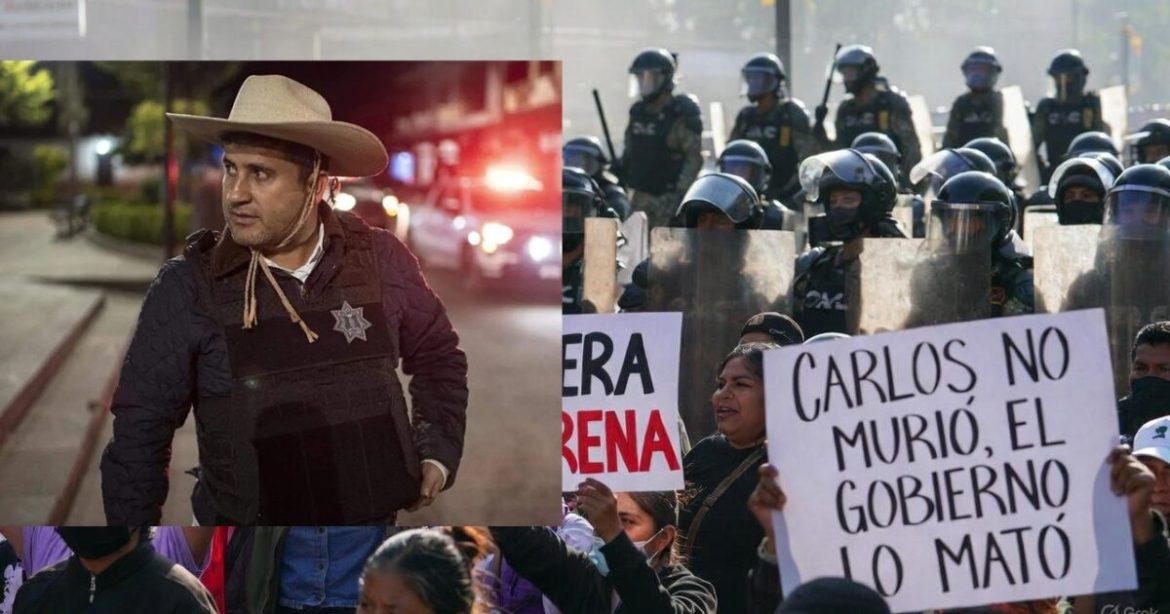

Mexicans are done. They want their country back. A massive protest was organized on the 15th of November, triggered by the cartel assassination of Carlos Manzo, the mayor of Uruapan and an outspoken opponent of the narco traffickers.
Manzo, who wore a signature white cowboy hat and displayed a sheriff’s star on his body armor, would get on helicopters and order his police to shoot at cartel members, taking a hardline “shoot first and ask questions later” approach.
On November 1, during a Day of the Dead event, he was shot dead in the middle of his town in front of a large crowd.
His killing immediately sparked demonstrations in Michoacán that quickly spread nationwide. In Mexico’s Michoacán State, seven mayors have been killed and one kidnapped since 2021.
Uruapan’s Carlos Manzo was the third mayor assassinated in the state this year and the eleventh nationwide over the past year.
Many Mexicans see him as a hero, compared by some influencers to Charlie Kirk, for the hope he brought to people who believed the cartels could be defeated.
As one Mexican influencer wrote on Instagram, “He wanted a brighter future for Mexico, a future without corruption. Assassinated. Broad daylight.”
A group calling itself “Generation Z Mexico” circulated a manifesto online claiming to be non-partisan and representing young people fed up with insecurity, corruption, violence, and abuse of power.
The demonstrations took place in more than 50 cities across Mexico, as well as in the United States, Canada, the Netherlands, and Germany. About 17,000 people reportedly attended the Mexico City march.
Whether the protest was truly a “Gen Z” movement remains heavily disputed, as demonstrators came from all age groups, from retirees to young people, from wealthy residents to working-class families.
High-profile conservative figures, including former president Vicente Fox and billionaire Ricardo Salinas Pliego, endorsed the protests, while President Sheinbaum accused right-wing parties and foreign actors of infiltrating the movement and promoting it with bots, insisting that only a small number of young people were actually present.
Chanting “Sheinbaum is a narco-president,” demonstrators demanded that the authorities finally confront the drug cartels and corruption within the government.
Protesters accused the administration of colluding with cartels and allowing a “narco-state” to flourish. They called for the president’s resignation and demanded a tougher stance against the cartels.
Many shouted that the alleged pact between the government and the narcos must end immediately, with specific chants including “Out Morena,” “Carlos did not die, the government killed him,” and “We are all Carlos Manzo.”
Demonstrators wore white clothing and cowboy hats in Manzo’s honor, carried signs declaring “We are all Carlos Manzo,” and waved One Piece flags, a symbol widely associated with Gen Z protest movements.
Ahead of the protest, the government erected barriers around the National Palace, which serves as both the presidential residence and the seat of the federal executive.
Protesters charged the barricades, and police used tear gas and concussion grenades to disperse the crowd. At least 120 people were injured — around 100 of them police officers — and authorities announced between 20 and 40 arrests, depending on the source, for crimes including robbery and assault. Protesters accused police of beatings and heavy-handed tactics throughout the standoff.
President Sheinbaum dismissed the march as a right-wing operation amplified by political rivals, saying these were “right-wing fascist bots” and insisting that such people “don’t really exist in Mexico” and that most citizens support her.
She condemned the violence but argued that the most aggressive acts were carried out by hooded groups. Her administration maintains that national security efforts are underway and that it has taken steps against cartels while avoiding a full-scale drug war.
However, the fact that the cartels continue to operate, kill civilians, and wield enormous influence over the government remains irrefutable, and Sheinbaum has made public statements that many observers view as proof she is aligned with them.
Refusing to deploy the army or declare war on the cartels, she has said she will not “randomly kill people,” arguing that fighting the cartels is “outside the framework of the law” and that returning to war against the narcos would be “authoritarian” and “fascism,” adding, “It is impermissible to kill without any trial.”
In essence, Sheinbaum is publicly stating that she will not fight the cartels and will not attempt to dismantle a system that keeps Mexico poor while enriching politicians willing to cooperate with organized crime.
Protesters spray-painted the words “narco state” on the barriers protecting Sheinbaum’s residence, and the facts support their claims. Michoacán Governor Ramírez Bedolla’s cartel connections are well documented.
Leaked U.S. Drug Enforcement Administration intelligence links him to the criminal group Los Viagras through his aunt, Anabel Marín Bedolla, the wife of Adalberto Comparán Rodríguez, the former mayor of Aguililla now detained in the United States on drug trafficking charges.
Journalist Anabel Hernández has alleged that Cárteles Unidos operates under Alfredo Ramírez Bedolla’s protection, and during his administration seven municipal presidents in Michoacán have been killed.
Hipólito Mora accused Cárteles Unidos of intervening in the June 2021 election to help Ramírez Bedolla win for Morena, saying “Cárteles Unidos worked to support Morena,” and Carlos Manzo openly accused the governor and the state police of corruption.
Serious allegations also extend to national politics. A trafficker-turned-informant told DEA agents he negotiated and delivered roughly $2 million to López Obrador’s 2006 campaign.
According to confidential government documents, campaign workers throughout that race were approached by “unidentified individuals” offering “cash or high value items,” and it was understood that these individuals represented the local drug cartel.
Although corruption or direct payments to the president are yet to be proved, what is clear is that she has no intention of confronting the cartels and will maintain the status quo.
That decision leaves Mexico exposed to U.S. extra-territorial anti-narcotrafficking enforcement carried out by the U.S. military.
The post Mexico Anti Narco Protests – President Sheinbaum Blames the Right and Refuses to Tackle the Cartels appeared first on The Gateway Pundit.

